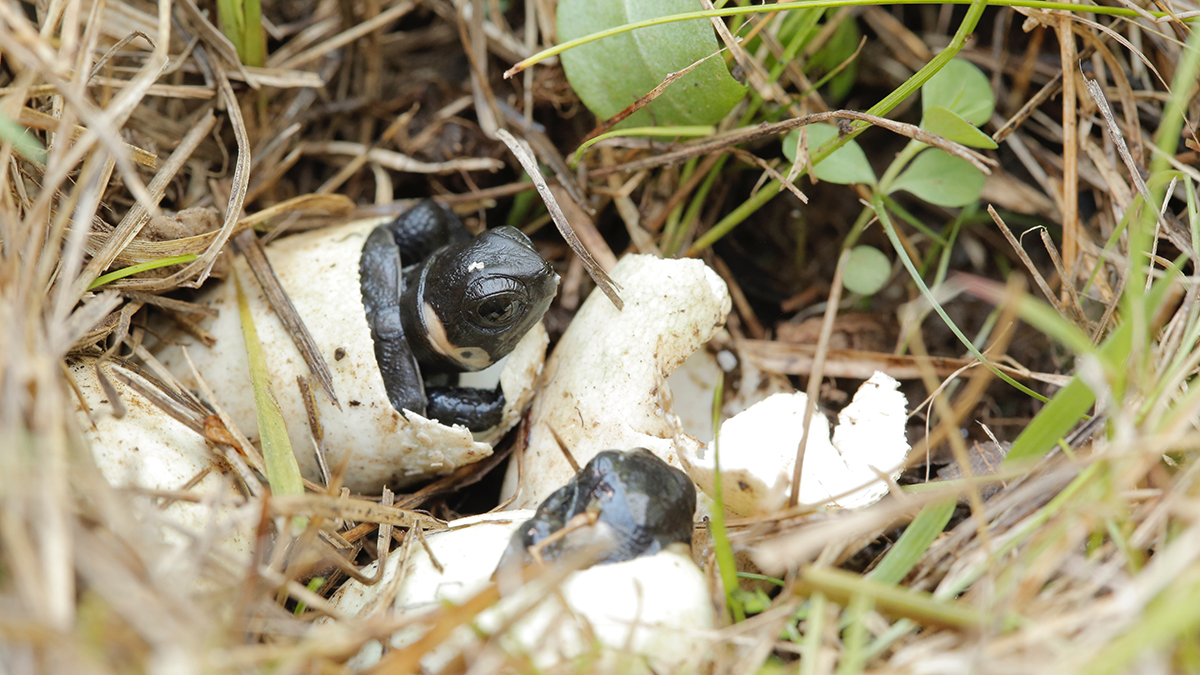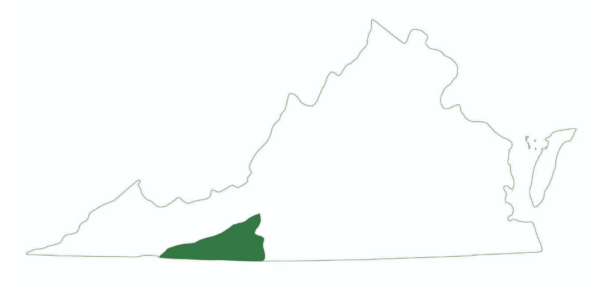Fact File
Scientific Name: Clemmys (=Glyptemys) muhlenbergii
Classification: Reptilia, Order Testudines, Family Emydidae
Conservation Status:
- State Endangered in Virginia
- Species of Greatest Conservation Need-Tier 1a on the Virginia Wildlife Action Plan
Identifying Characteristics

Photo by J.D. Kleopfer/DWR

Photo by USFWS
North America’s smallest turtle, the bog turtle is a freshwater turtle that has a maximum carapace length of 4.5 inches. The carapace is light brown to mahogany or black, and slightly domed with a low keel. The carapace is roughened with growth rings that are dark brown to black, sometimes with irregular radiations or markings, and has a smooth posterior rim. A conspicuous orange, yellow, or red blotch occurs behind each eye. The hinge-less plastron is mostly black, with some irregular yellow to cream-colored blotches and is concave in males. Males are larger than females, with a noticeably larger tail.
This species is not sexually mature until 6 years of age. It breeds from late April to early June, in shallow water and on land, and eggs hatch in the fall. There may be two clutches per year and it takes from 50-59 days for the eggs to hatch. The eggs are laid in shallow nests in grass tussocks, moss, or soft soils.

Photo by Mike Knoerr
This species is active only during April, May, June and September and aestivates during high temperatures. It is usually seen only during the early spring and during the nesting season because the dead and matted grasses and sedges form a dense ground cover during late spring and summer. During the winter, this turtle hibernates below the frost depth in holes, muskrat burrows, in sedge clumps, or in the mud of waterways. The mean home range is 3.2 acres. Bog turtles bask during midday on grass mats or in shallow rivulets.
Habitat
Bog turtles occupy spring-fed wetlands, and use areas with soft, deep substrate and persistent shallow water. Sedge-dominated wetlands may provide important structure through their tussock or hummock-forming growth. Wetlands occupied by bog turtles tend to have areas that are permanently saturated, even in draught years, and low-strength soils.
Nests are placed at slightly elevated locations, often on sedge or sphagnum hummocks in wetland areas with sun exposure. Egg mortality can occur if nests flood or the eggs desiccate.
Distribution:
This species is found in six counties in southwest Virginia, only in the southern Blue Ridge Plateau above 610 meters elevation. It inhabits sphagnum bogs or wet sedge meadows in or near slow-moving streams with a muddy bottom. The highest populations occur in the shrub stage of forest succession. Alder, skunk cabbage, and sedges are common plant associations.

Did you know?
This is North America’s smallest turtle!
Conservation
The bog turtle was listed as a state endangered species in Virginia in 1987 because of collection for the pet trade. The northern population (found in Connecticut, Delaware, Maryland, Massachusetts, New Jersey, New York, and Pennsylvania) was listed as federally threatened in 1997, and the southern population (found in Georgia, North Carolina, South Carolina, Tennessee, and Virginia) is listed as “threatened by similarity of appearance” to the northern bog turtle population because of pet trade collection.
Last updated: August 14, 2024
The Virginia Department of Wildlife Resources Species Profile Database serves as a repository of information for Virginia’s fish and wildlife species. The database is managed and curated by the Wildlife Information and Environmental Services (WIES) program. Species profile data, distribution information, and photography is generated by the Virginia Department of Wildlife Resources, State and Federal agencies, Collection Permittees, and other trusted partners. This product is not suitable for legal, engineering, or surveying use. The Virginia Department of Wildlife Resources does not accept responsibility for any missing data, inaccuracies, or other errors which may exist. In accordance with the terms of service for this product, you agree to this disclaimer.

